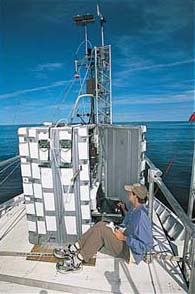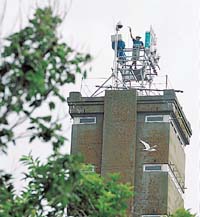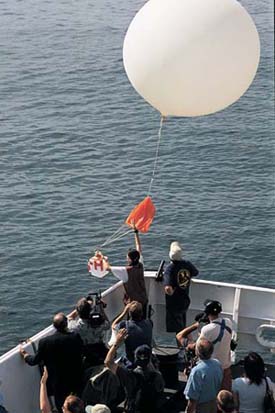 |
 |
| current issue |  |
past issues |  |
send a letter/news |  |
address update |  |
advertise |  |
about us |  |
alumni home |
Features
Air HeadsPage 2 of 4

|
At the heart of the study are the complex, computer-based mathematical models used to predict air quality based on emissions data, meteorology, chemistry and other factors. Researchers crank out predictions on a daily basis; others then probe the skies to verify or disprove the predictions. This is what grows the science.
Among other things, scientists are looking at what happens, chemically and physically, during the night—what senior scientist Fred Fehsenfeld with NOAA's Aeronomy Laboratory in Boulder, Colo., refers to as "the dark side of the force."
In addition, the scientists are gauging the impact of dust particles from Asian storms or forest fires in Alaska and Canada on the absorption of sunlight. They are looking at the pollutants from the smokestacks of coal-fired plants in the eastern United States and urban pollution from the entire Eastern Seaboard. They are measuring "biogenic," or natural emissions of hydrocarbons from the region's forests, and analyzing the influence that the coastal marine environment has on transforming pollutants. All of this has an impact on the quality of New England's air and, in turn, the air we export across the sea to Europe and beyond. It's a small world after all.
To conduct the massive, and massively complex, project, there is a long list of hardware: 12 aircraft, including British, French, German and Canadian planes; NOAA's P-3 "Hurricane Hunter" turboprop aircraft and its 274-foot-long Research Vessel Ronald H. Brown; four 12-pound, 10-foot "smart" balloons; three satellites and a number of ground-based air monitoring sites, including UNH's four state-of-the-art air quality observatories strategically located around the state.
And the DC-8. After a quick tour down the aisle, NASA mission manager Chris Jennison has me watch a pre-flight safety video so I'll know what to do in an emergency. Unlike the easy-to-ignore safety messages on commercial aircraft, this video is designed to get your full attention.

|
As it turns out, the plane has my attention already. I am surrounded by some two dozen state-of-the-art experimental contraptions, bolted to the floor, that are wheezing, popping, clicking, purring and off-gassing. Jennison mentions that all the instruments are hand made to measure air pollution down to parts per quadrillion, and consequently use fairly exotic materials. Nitric oxide, for example, is "amazingly toxic" and can combine with oxygen in the blood to cause suffocation. (All chemicals are double-contained and well vented, he assures me.) Jennison also points out the "extremely powerful" lasers on board, which require close coordination with the Federal Aviation Administration and, at times, even the North American Air Defense Command. With a laser zapping the atmosphere to measure ozone and aerosols up to 20 kilometers away, mission managers must be ever vigilant that other aircraft or satellites don't get inadvertently fried.
Much of the exotic scientific gadgetry stuffed into the plane looks as if Thomas Edison and Rube Goldberg put their heads together. Plastic tubing of all sizes and colors snakes down the fuselage, venting chemicals or delivering air to instruments. Windows have been popped out and replaced with metal plates perforated with a hodgepodge of air sampling inlets. ��
I feel as if I'm looking at time travel engineering, except for the menagerie of stuffed mascots and signs. A rubber chicken hangs in a noose with a placard reading, "Sacred offering for stable CO, N20, CH4." Another sign reads, "Yararrgh! Here be monsters of tha deep! Ye've been warned! —Aerosol Pirates."
After bumping along in low-level turbulence, we climb to 40,000 feet, level off and begin to spiral slowly downward in a six-mile-wide circle while NASA's Terra satellite passes over the same air space high above. This is the process of "truthing" the satellite: making the same measurements on board both craft and comparing the results in an effort to gauge the satellite's accuracy. This process will occur many times over the course of the project.

|
Some of the components of pollution being studied include ozone (smog), carbon monoxide and dioxide, nitric oxide, total reactive nitrogen, sulfur dioxide, formaldehyde, acetylene and perchloroethylene. All of these compounds are considered bad for people or the environment, or both: perchloroethylene, for example, comes primarily from dry cleaning fluid and has been linked to cancer and liver and kidney disease. Air pollution contributes to some 60,000 deaths a year in the United States, estimates Cameron Wake '93G, research associate professor with the Climate Change Research Center.
Sitting before a rack of instruments and computer screens, CCRC research project engineer Eric Scheuer '92 is measuring atmospheric gaseous nitric acid, a by-product of the nitrogen oxides emitted by car and truck engines. It's one of the primary ways nitrogen compounds, which can lead to ozone and acid rain, get transported long distances. Digital numbers flash up and down in response to changes in air temperature, density and water vapor. Using the tip of his sneaker, Scheuer makes delicate adjustments to the intake flow rate of his instrument, a UNH-built mist chamber-ion chromatograph.
While Scheuer is able to sit comfortably and toe-tap his instrument into shape ("It's a lot easier than bending down," he says), there is no rest for his colleague Jack Dibb, a CCRC research associate professor of earth sciences. Dibb is standing behind the nitric acid instrument, measuring aerosols. Wearing latex gloves, Dibb changes out filters every five minutes from hefty white plastic pipes. He places each one in a plastic bag and heat seals and labels it. These will go back to UNH for analysis.
Page: < Prev 1 2 3 4 Next >Easy to print version

